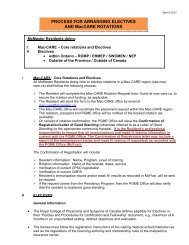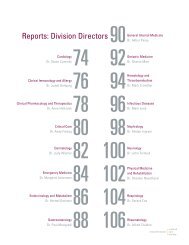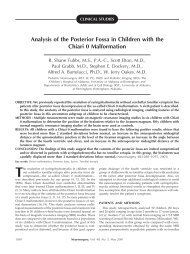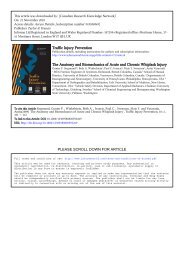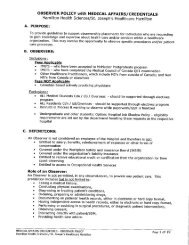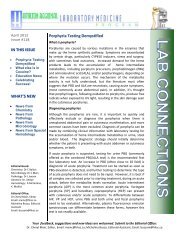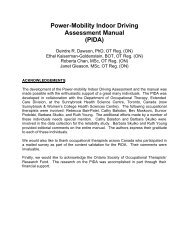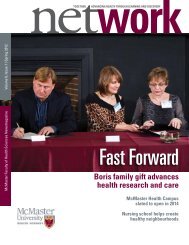An investigation into differences between the structure of ...
An investigation into differences between the structure of ...
An investigation into differences between the structure of ...
You also want an ePaper? Increase the reach of your titles
YUMPU automatically turns print PDFs into web optimized ePapers that Google loves.
American Journal <strong>of</strong> Psychology<br />
<strong>An</strong> <strong>investigation</strong> <strong>into</strong> <strong>differences</strong><br />
<strong>between</strong> <strong>the</strong> <strong>structure</strong> <strong>of</strong> temperament<br />
and <strong>the</strong> <strong>structure</strong> <strong>of</strong> personality<br />
IRINA TROFIMOVA<br />
McMaster University<br />
This article analyzes <strong>the</strong> <strong>differences</strong> <strong>between</strong> an activity-specific temperament model and <strong>the</strong><br />
Big Five personality model using <strong>the</strong> Structure <strong>of</strong> Temperament Questionnaire–Compact (STQ-<br />
77). The STQ-77 has 3 emotionality scales and 9 scales assessing 3 dynamic aspects (arousal,<br />
lability, and sensory sensitivity) in 3 areas <strong>of</strong> activity (physical, verbal–social, and mental). The<br />
results <strong>of</strong> administration <strong>of</strong> <strong>the</strong> Russian STQ-77, NEO-FFI, and SSS-V to 174 Russian participants<br />
showed how components <strong>of</strong> temperament can represent <strong>the</strong> traits described in <strong>the</strong> Big Five<br />
model. The confirmatory factor analysis <strong>of</strong> <strong>the</strong> English STQ-77 and <strong>the</strong> results <strong>of</strong> a study involving<br />
a prolonged word classification task with 221 Canadian participants showed <strong>the</strong> benefits<br />
<strong>of</strong> <strong>the</strong> activity-specific approach, separating temperament traits in three areas <strong>of</strong> activity. Such<br />
specificity <strong>of</strong> temperament traits differentiates <strong>the</strong>m from personality traits.<br />
Personality assessment methods analyze <strong>the</strong> product<br />
<strong>of</strong> interactions <strong>between</strong> <strong>the</strong> social and biological<br />
factors underlying individual <strong>differences</strong>. However,<br />
<strong>the</strong> concept <strong>of</strong> personality should not be viewed as<br />
completely covering <strong>the</strong> concepts <strong>of</strong> individuality<br />
or <strong>of</strong> <strong>the</strong> person, even though <strong>the</strong>se concepts overlap.<br />
The concept <strong>of</strong> personality refers to a product<br />
<strong>of</strong> socialization, such as social skills, attitudes, selfperception,<br />
and relationships to o<strong>the</strong>r people, and <strong>the</strong><br />
concept <strong>of</strong> individuality includes not only personality<br />
but also abilities, limitations, and o<strong>the</strong>r biologically<br />
based properties <strong>of</strong> a person. Allport, who initiated<br />
<strong>the</strong> lexical approach (so popular nowadays in personality<br />
<strong>the</strong>ory), pointed to <strong>the</strong> confusion <strong>between</strong><br />
personality and <strong>the</strong> factors underlying personality.<br />
He noted that “tests for physique, for intelligence,<br />
or for temperament are not tests <strong>of</strong> personality. . . .<br />
If, <strong>the</strong>n, personality is <strong>the</strong> object <strong>of</strong> inquiry, traits <strong>of</strong><br />
personality should not be confused with qualities or<br />
quantities <strong>of</strong> intelligence, physique, or temperament”<br />
(Allport, 1927, p. 284).<br />
<strong>An</strong>o<strong>the</strong>r topic <strong>of</strong> confusion is <strong>the</strong> nature <strong>of</strong> <strong>the</strong><br />
relationship <strong>between</strong> temperament and personality.<br />
Researchers in personality <strong>the</strong>ory and developmental<br />
psychology tend to assign a leading role to personality<br />
as <strong>the</strong> main edifice <strong>of</strong> adult and socialized individuality<br />
and a submissive role to temperament as <strong>the</strong> foundation<br />
<strong>of</strong> this edifice, which plays a role only during <strong>the</strong><br />
Winter 2010, Vol. 123, No. 4 pp. 489–502 • © 2010 by <strong>the</strong> Board <strong>of</strong> Trustees <strong>of</strong> <strong>the</strong> University <strong>of</strong> Illinois<br />
1<br />
2<br />
3<br />
4<br />
5<br />
6<br />
7<br />
8<br />
9<br />
10<br />
11<br />
12<br />
13<br />
14<br />
15<br />
16<br />
17<br />
18<br />
19<br />
20<br />
21<br />
22<br />
23<br />
24<br />
25<br />
26<br />
27<br />
28<br />
29<br />
30<br />
31<br />
32<br />
33<br />
34<br />
35<br />
36<br />
37<br />
38<br />
39<br />
40<br />
41<br />
42<br />
43<br />
44<br />
45<br />
46<br />
47<br />
48
1<br />
2<br />
3<br />
4<br />
5<br />
6<br />
7<br />
8<br />
9<br />
10<br />
11<br />
12<br />
13<br />
14<br />
15<br />
16<br />
17<br />
18<br />
19<br />
20<br />
21<br />
22<br />
23<br />
24<br />
25<br />
26<br />
27<br />
28<br />
29<br />
30<br />
31<br />
32<br />
33<br />
34<br />
35<br />
36<br />
37<br />
38<br />
39<br />
40<br />
41<br />
42<br />
43<br />
44<br />
45<br />
46<br />
47<br />
48<br />
initial stage <strong>of</strong> construction (i.e., in childhood). Continuing<br />
<strong>the</strong> building analogy, one should not forget<br />
that <strong>the</strong>re are plumbing and electrical systems, which<br />
run from <strong>the</strong> foundation. If something goes wrong<br />
with <strong>the</strong>se systems, or (as in <strong>the</strong> case <strong>of</strong> <strong>the</strong> Tower <strong>of</strong><br />
Pisa) <strong>the</strong>re are problems with <strong>the</strong> underground support<br />
<strong>of</strong> <strong>the</strong> foundation, <strong>the</strong> functioning <strong>of</strong> <strong>the</strong> whole<br />
<strong>structure</strong> is affected. There is an overwhelming body<br />
<strong>of</strong> evidence that a person’s social behavior changes<br />
with biological factors, such as pain, <strong>into</strong>xication,<br />
chemical imbalances, or even time <strong>of</strong> <strong>the</strong> day, with all<br />
<strong>the</strong> social settings remaining intact.<br />
It would be more realistic to treat social and<br />
biological factors, personality and temperament, as<br />
equal parties, having a continual interaction and mutual<br />
adjustment to one ano<strong>the</strong>r. Such interaction is<br />
more noticeable in childhood because <strong>of</strong> <strong>the</strong> larger<br />
and faster changes in both <strong>the</strong> biological and social<br />
characteristics <strong>of</strong> individuality, but it does not end<br />
with adulthood. For example, people with a high<br />
tempo in physical activity or an ability to sustain intense<br />
physical activity become athletes not because<br />
<strong>of</strong> <strong>the</strong>ir socialization but because <strong>of</strong> <strong>the</strong>ir actual<br />
physical abilities. The same mechanisms (i.e., <strong>the</strong><br />
impact <strong>of</strong> <strong>the</strong> biologically based abilities) make <strong>the</strong><br />
same person withdraw from athletic activities in later<br />
life when <strong>the</strong>se abilities change. <strong>An</strong>o<strong>the</strong>r example is<br />
<strong>the</strong> decrease in extroversion and sociability with age<br />
(Labouvie-Vief, Diehl, Tarnowski, & Shen, 2000;<br />
Mortimer, Finch, & Kumka, 1982; Yang, McCrae, &<br />
Costa, 1998; Zonderman, Siegler, Barefoot, Williams,<br />
& Costa, 1993), accompanied by such biological factors<br />
as an age-related decrease in energy level and an<br />
increase in emotionality. The best opinion on this<br />
topic comes from Gray (2004), who said, “consciousness<br />
comes too late,” meaning that a person <strong>of</strong>ten acts<br />
first <strong>the</strong>n thinks and assesses her or his own actions<br />
from a social perspective afterwards.<br />
Sometimes <strong>the</strong>re is a need in practice to focus primarily<br />
on ei<strong>the</strong>r social factors (e.g., cultural expectations,<br />
acculturation factors, values, and opinions) or<br />
biological factors and not on <strong>the</strong> product <strong>of</strong> <strong>the</strong>ir interaction.<br />
Consistent individual <strong>differences</strong> in behavior,<br />
which are based on <strong>the</strong> physiology <strong>of</strong> <strong>the</strong> body, were<br />
noted 25 centuries ago by Hippocrates and Galen<br />
as temperament. Unlike <strong>the</strong> concept <strong>of</strong> personality<br />
(which includes <strong>the</strong> content aspects <strong>of</strong> behavior, e.g.,<br />
values, goals, attitudes, and a history <strong>of</strong> relationships),<br />
490 • tr<strong>of</strong>imova<br />
<strong>the</strong> concept <strong>of</strong> temperament refers mostly to <strong>the</strong> dynamic<br />
properties <strong>of</strong> behavior, independent <strong>of</strong> content<br />
elements. “Emotionality” and “activity” (or “energy,”<br />
or “strength <strong>of</strong> nervous system,” i.e., <strong>the</strong> ability to stay<br />
active on a task) are two dimensions used by Kant<br />
(1798/1974), Stern (1900; cited in Lamiell, 2003),<br />
Heymans (1929), and Pavlov (1941) to derive <strong>the</strong> Galen–Hippocrates<br />
four temperaments. Cholerics were<br />
noted to be reactive and energetic, sanguines were<br />
balanced in reaction and energetic, phlegmatics were<br />
balanced and weak, and melancholics were reactive<br />
and weak. Later, <strong>the</strong> neuropsychological correlates<br />
<strong>of</strong> <strong>the</strong>se two basic dimensions <strong>of</strong> temperament were<br />
found: The neuroendocrine functioning <strong>of</strong> <strong>the</strong> limbic<br />
system was linked to emotionality, and projections<br />
from <strong>the</strong> ascending reticular activation system were<br />
linked to <strong>the</strong> level <strong>of</strong> activation and arousal. Therefore,<br />
it is not surprising that <strong>the</strong> same two dimensions—<br />
emotionality (perceived as neuroticism) and arousal<br />
level (perceived as extroversion)—are always found<br />
in all personality models based on a lexical approach<br />
and factor analysis.<br />
The oldest experimental tradition for studying <strong>the</strong><br />
components <strong>of</strong> temperament belongs to <strong>the</strong> 100-yearold<br />
Pavlovian school <strong>of</strong> psychophysiological studies<br />
<strong>of</strong> <strong>the</strong> properties <strong>of</strong> nervous systems and to <strong>the</strong><br />
worldwide tradition <strong>of</strong> <strong>the</strong> study <strong>of</strong> human abilities.<br />
Dozens <strong>of</strong> researchers supervised by Pavlov, Teplov,<br />
Nebylitsyn, and Rusalov throughout <strong>the</strong> 20th century<br />
conducted experiments with animals and with human<br />
participants in various modalities, using variable<br />
scheduling and difficulty <strong>of</strong> tasks, administration <strong>of</strong><br />
caffeine, provision <strong>of</strong> tasks with deterministic and<br />
probabilistic conditions, measurement <strong>of</strong> absolute<br />
thresholds, evoked potentials, and electroencephalography.<br />
These researchers came up with <strong>the</strong> following<br />
findings, in addition to <strong>the</strong> description <strong>of</strong> <strong>the</strong><br />
two basic dimensions <strong>of</strong> temperament (Gray, 1964;<br />
Nebylitsyn, 1972; Pavlov, 1941; Teplov & Nebylitsyn,<br />
1963; Rusalov, 1979):<br />
Excitation and inhibition processes are regulated<br />
by different neurophysiological systems, and<br />
<strong>the</strong> relationships <strong>between</strong> <strong>the</strong>se two systems<br />
(<strong>the</strong>ir balance) are not <strong>the</strong> same for all people,<br />
leading to consistent individual <strong>differences</strong>.<br />
This idea was fur<strong>the</strong>r developed by Gray in his<br />
reinforcement sensitivity <strong>the</strong>ory. Elucidating <strong>the</strong><br />
relationships <strong>between</strong> various brain <strong>structure</strong>s,
Gray (1982) explained Hippocrates’ four classical<br />
temperaments in terms <strong>of</strong> <strong>the</strong> relationship<br />
<strong>between</strong> <strong>the</strong> Behavioral Approach System<br />
(BAS) and <strong>the</strong> Behavioral Inhibition System<br />
(BIS). Impulsivity was explained by <strong>the</strong> dominance<br />
<strong>of</strong> <strong>the</strong> BAS over <strong>the</strong> BIS, and neuroticism<br />
was attributed to <strong>the</strong> dominance <strong>of</strong> <strong>the</strong> BIS over<br />
<strong>the</strong> weaker BAS. This approach was later adapted<br />
by numerous approach–withdrawal models<br />
<strong>of</strong> temperament.<br />
Mobility <strong>of</strong> activity, and not just <strong>the</strong> energetic<br />
component <strong>of</strong> activity, is also a very consistent<br />
and biologically based trait. Mobility appears as<br />
plasticity <strong>of</strong> behavior (i.e., how easily <strong>the</strong> person<br />
can start or stop activity and how flexible and<br />
adaptive <strong>the</strong> person is to new circumstances or<br />
instructions). Since <strong>the</strong> neuropsychological work<br />
<strong>of</strong> Luria in <strong>the</strong> 1940s, mobility (plasticity) <strong>of</strong> behavior<br />
was linked to <strong>the</strong> functioning <strong>of</strong> <strong>the</strong> frontal<br />
cortex and confirmed by numerous clinical cases<br />
<strong>of</strong> brain damage. The important issue about<br />
mobility is that, since Pavlov’s time, it has been<br />
found to have bifurcation (nonlinear) <strong>structure</strong><br />
and <strong>the</strong>refore a nonindependent relationship to<br />
<strong>the</strong> energetic component <strong>of</strong> temperament. Pavlov<br />
classified nervous systems <strong>into</strong> weak and strong<br />
types and differentiated only <strong>the</strong> strong types<br />
by <strong>the</strong> mobility criterion, whereas <strong>the</strong> weak type<br />
was found in many studies to always have low<br />
mobility. As a result, mobility, as measured by <strong>the</strong><br />
Pavlovian Temperament Survey (PTS), shows<br />
significant positive correlations with <strong>the</strong> Strength<br />
<strong>of</strong> Excitation scale <strong>of</strong> <strong>the</strong> PTS (Strelau, 1999) and<br />
with both <strong>the</strong> Ergonicity (power <strong>of</strong> arousal) and<br />
Lability (<strong>of</strong> <strong>the</strong> arousal) scales <strong>of</strong> <strong>the</strong> Structure<br />
<strong>of</strong> Temperament Questionnaire (STQ) administered<br />
by Strelau on Polish and German samples,<br />
by Ruch, <strong>An</strong>gleitner, and Strelau (1991) on a German<br />
sample, and by Tr<strong>of</strong>imova (2009a, 2010b)<br />
based on a Canadian sample. Such interdependence<br />
<strong>of</strong> <strong>the</strong> mobility and energetic component<br />
<strong>of</strong> temperament implies that mobility should<br />
show up as an independent factor and hiding<br />
under <strong>the</strong> dimension <strong>of</strong> general arousal in factor<br />
analytic studies.<br />
Lability (i.e., tempo <strong>of</strong> activity) was found to<br />
be a dynamic property <strong>of</strong> activity separate from<br />
flexibility and adaptivity. The concept <strong>of</strong> lability<br />
described <strong>the</strong> speed <strong>of</strong> automatic performance<br />
according to an existing program (or habit, or<br />
previously developed skill) and was differenti-<br />
ated from general mobility, or plasticity, needed<br />
for putting toge<strong>the</strong>r a new program <strong>of</strong> an action<br />
under changed circumstances. Findings in neurophysiology<br />
linked lability, time keeping, rhythmicity,<br />
and tempo <strong>of</strong> activity to <strong>the</strong> basal ganglia,<br />
dentate nucleus <strong>of</strong> <strong>the</strong> lateral cerebellum, putamen,<br />
and thalamic projections to <strong>the</strong> sensorimotor<br />
cortex, superior temporal gyrus, and inferior<br />
frontal gyrus (Franz, Zelaznik, & Smith, 1992;<br />
Franz, Ivry, & Helmuth, 1996; Ivry & Keele,<br />
1989; Harrington, Haaland, & Hermanowicz,<br />
1998; O’Boyle, 1997; Rao et al., 1997).<br />
Sensitivity is also a biologically based trait affecting<br />
<strong>the</strong> behavior <strong>of</strong> a person, and it is also<br />
nonindependent on <strong>the</strong> energetic component <strong>of</strong><br />
activity. Teplov and Nebylitsyn (1963) measured<br />
absolute visual and auditory thresholds and <strong>the</strong><br />
electrical sensitivity <strong>of</strong> <strong>the</strong> eye and found that<br />
“weak” participants had a higher sensitivity (i.e.,<br />
lower threshold). Similar results were found by<br />
Eysenck’s school (Stelmack & Michaud-Achorn,<br />
1985; Revelle, 1973; Gange, Geen, & Harkins,<br />
2007). This meant that sensitivity and endurance<br />
<strong>of</strong> activity were not independent properties <strong>of</strong><br />
individuality, even though <strong>the</strong>y had different neurophysiological<br />
representation.<br />
Nebylitsyn (1976) and <strong>the</strong>n Rusalov (1979, 1989)<br />
concluded that <strong>the</strong> components <strong>of</strong> temperament<br />
are activity-specific; for example, <strong>the</strong> energetic<br />
level or tempo <strong>of</strong> performance might be different<br />
for <strong>the</strong> same person in physical, social, or<br />
intellectual activities, and <strong>the</strong>refore aspects <strong>of</strong><br />
<strong>the</strong> performance <strong>of</strong> <strong>the</strong>se activities should be assessed<br />
and analyzed separately. These findings<br />
were in line with neuropsychological descriptions<br />
<strong>of</strong> <strong>the</strong> role <strong>of</strong> <strong>the</strong> sensorimotor cortex in<br />
<strong>the</strong> regulation <strong>of</strong> physical activity, <strong>the</strong> role <strong>of</strong> <strong>the</strong><br />
left temporal cortex in verbal behavior, and <strong>the</strong><br />
role <strong>of</strong> <strong>the</strong> frontal cortex in intellectual activity.<br />
It would be simplistic to assign performance<br />
in social, physical, and intellectual activities to<br />
exact anatomic <strong>structure</strong>s <strong>of</strong> <strong>the</strong> brain, given<br />
that any activity is performed by an ensemble <strong>of</strong><br />
<strong>structure</strong>s. However, it is reasonable to suggest<br />
that membership in <strong>the</strong>se ensembles changes<br />
with a change in <strong>the</strong> object <strong>of</strong> activity and that<br />
at least for physical, verbal–social, and mental<br />
activities, <strong>the</strong> consistent dynamic aspects <strong>of</strong><br />
<strong>the</strong>se activities (e.g., energetic level and tempo)<br />
are regulated by different neurophysiological<br />
systems. Hebb (1980, p. 64) pointed out that<br />
temperament and personality • 491<br />
1<br />
2<br />
3<br />
4<br />
5<br />
6<br />
7<br />
8<br />
9<br />
10<br />
11<br />
12<br />
13<br />
14<br />
15<br />
16<br />
17<br />
18<br />
19<br />
20<br />
21<br />
22<br />
23<br />
24<br />
25<br />
26<br />
27<br />
28<br />
29<br />
30<br />
31<br />
32<br />
33<br />
34<br />
35<br />
36<br />
37<br />
38<br />
39<br />
40<br />
41<br />
42<br />
43<br />
44<br />
45<br />
46<br />
47<br />
48
1<br />
2<br />
3<br />
4<br />
5<br />
6<br />
7<br />
8<br />
9<br />
10<br />
11<br />
12<br />
13<br />
14<br />
15<br />
16<br />
17<br />
18<br />
19<br />
20<br />
21<br />
22<br />
23<br />
24<br />
25<br />
26<br />
27<br />
28<br />
29<br />
30<br />
31<br />
32<br />
33<br />
34<br />
35<br />
36<br />
37<br />
38<br />
39<br />
40<br />
41<br />
42<br />
43<br />
44<br />
45<br />
46<br />
47<br />
48<br />
<strong>the</strong> arousal system consists <strong>of</strong> 28 separate pairs<br />
<strong>of</strong> nuclei, which make possible many different<br />
patterns <strong>of</strong> activity, all with <strong>the</strong> same purpose <strong>of</strong><br />
activating <strong>the</strong> cortex but with different properties<br />
o<strong>the</strong>rwise.<br />
Based on his experiments, Rusalov (1979) proposed<br />
<strong>the</strong> Structure <strong>of</strong> Temperament <strong>the</strong>ory and<br />
developed his STQ. The Extended version <strong>of</strong> <strong>the</strong><br />
STQ has 12 (4 × 3) scales consisting <strong>of</strong> 12 items each,<br />
which analyze four temperamental traits: Ergonicity<br />
(determined by endurance <strong>of</strong> activity), Plasticity,<br />
Tempo <strong>of</strong> activity, and Emotionality in three areas <strong>of</strong><br />
activity: social, physical, and intellectual (Rusalov,<br />
1989, 1997; Rusalov & Tr<strong>of</strong>imova, 2007). 1 A factor<br />
analysis conducted on <strong>the</strong> data from 1,937 participants<br />
showed that scales grouped consistently <strong>into</strong><br />
four factors, organized around <strong>the</strong> type <strong>of</strong> activity<br />
(physical or motor, social, intellectual) and emotionality.<br />
Studies <strong>of</strong> <strong>the</strong> English version <strong>of</strong> <strong>the</strong> STQ<br />
(STQ-E) using American, Australian, and Canadian<br />
samples demonstrated that its scales have an activityspecific<br />
factor <strong>structure</strong> similar to that <strong>of</strong> <strong>the</strong> Russian<br />
language version and that it has good reliability and<br />
internal consistency (Bishop, Jacks, & Tandy, 1993;<br />
Bishop & Hertenstein, 2004; Dumenci, 1995, 1996<br />
[using initial STQ]; Rusalov, 1997; Stough, Brebner,<br />
& Cooper, 1991; Rusalov & Tr<strong>of</strong>imova, 2007; Tr<strong>of</strong>imova,<br />
2010a). Chinese (STQ-C), Urdu (STQ-U),<br />
and Polish (STQ-P) Extended versions <strong>of</strong> <strong>the</strong> STQ,<br />
administered among corresponding populations,<br />
demonstrated robust factor <strong>structure</strong>s similar to those<br />
<strong>of</strong> <strong>the</strong> original version (Tr<strong>of</strong>imova, 2010a).<br />
The compact version <strong>of</strong> <strong>the</strong> STQ (STQ-77) consists<br />
<strong>of</strong> 6 out <strong>of</strong> 12 items taken from each scale <strong>of</strong> <strong>the</strong><br />
Extended STQ (Rusalov & Tr<strong>of</strong>imova, 2007). In <strong>the</strong><br />
STQ-77, <strong>the</strong> initial items <strong>of</strong> <strong>the</strong> STQ’s Emotionality<br />
scales were regrouped <strong>into</strong> <strong>the</strong> STQ-77 scales <strong>of</strong><br />
Empathy, Self-Confidence, and Neuroticism, based<br />
on several factor analytic studies <strong>of</strong> <strong>the</strong> STQ that consistently<br />
showed that <strong>the</strong> three former Emotionality<br />
scales (Motor Emotionality, Social Emotionality, and<br />
Intellectual Emotionality) were not as activity specific<br />
as <strong>the</strong> Ergonicity, Plasticity, and Tempo scales<br />
and basically constituted one factor (Bishop et al.,<br />
1993; Bishop & Hertenstein, 2004; Dumenci, 1996;<br />
Rusalov, 2004; Stough et al., 1991; Rusalov & Tr<strong>of</strong>imova,<br />
2007; Tr<strong>of</strong>imova, 2010a; Tr<strong>of</strong>imova & Sulis,<br />
2010; Watkins, Mortazavi, & Tr<strong>of</strong>imova, 2000). The<br />
492 • tr<strong>of</strong>imova<br />
original STQ scale <strong>of</strong> Intellectual Plasticity was renamed<br />
Sensitivity to Probabilities. The STQ-77 also<br />
upgraded Rusalov’s original model <strong>of</strong> temperament<br />
by including <strong>the</strong> scales <strong>of</strong> Impulsivity, Sensitivity to<br />
Sensations, and Empathy. The last two new scales<br />
were included according to Luria’s (1996) neuropsychological<br />
description <strong>of</strong> a so-called sensory-informational<br />
block <strong>of</strong> brain <strong>structure</strong>s controlling <strong>the</strong> tuning<br />
<strong>of</strong> attention to certain types <strong>of</strong> stimuli and information.<br />
The discovery <strong>of</strong> mirror neurons supported<br />
<strong>the</strong> hypo<strong>the</strong>sis <strong>of</strong> <strong>the</strong> biological origin <strong>of</strong> empathy as<br />
a sensitivity to people’s intentions and feelings, <strong>the</strong><br />
trait described by Rogers in <strong>the</strong> mid-1970s (Rogers,<br />
1975). A person’s attraction to activities <strong>of</strong> physical<br />
danger or risk taking, described by Zuckerman (1979)<br />
as sensation seeking, was linked to a deficiency in<br />
dopamine regulation. Thus empathy and sensation<br />
seeking were considered biologically based components<br />
<strong>of</strong> individuality.<br />
In summary, <strong>the</strong> STQ-77 describes <strong>the</strong> <strong>structure</strong><br />
<strong>of</strong> temperament as having four dimensions related to<br />
emotionality and to three dynamic aspects <strong>of</strong> activity—arousal<br />
(energetic aspect), lability, and sensory<br />
preferences—all applied to intellectual, communicative,<br />
and physical areas <strong>of</strong> activity Emotionality is<br />
presented in this model as a limbic-driven amplifier<br />
<strong>of</strong> arousal, lability, and <strong>the</strong> sensory orientation aspects<br />
<strong>of</strong> activity (Table 1). In contrast to <strong>the</strong> Big Five model<br />
<strong>of</strong> personality, this model includes not only aspects<br />
<strong>of</strong> social activities but also consistent characteristics<br />
<strong>of</strong> behavior related to physical and mental activities.<br />
Also in contrast to <strong>the</strong> Big Five, <strong>the</strong> STQ-77 was derived<br />
not from factor analysis but from experimental<br />
and psychophysiological studies <strong>of</strong> biologically<br />
based individual <strong>differences</strong>. The 12 components <strong>of</strong><br />
temperament, which <strong>the</strong> STQ-77 measures, are not<br />
all independent, as <strong>the</strong> background <strong>the</strong>ory and research<br />
<strong>of</strong> <strong>the</strong> STQ assumes nonlinear, feedback, and<br />
causal relationships <strong>between</strong> <strong>the</strong> psychophysiological<br />
mechanisms underlying <strong>the</strong>se dynamic aspects<br />
<strong>of</strong> behavior. Because <strong>of</strong> <strong>the</strong> complex nature <strong>of</strong> <strong>the</strong><br />
relationships <strong>between</strong> <strong>the</strong> components <strong>of</strong> <strong>the</strong> STQ-<br />
77 model, we could expect that in a factor analysis<br />
<strong>the</strong>se 12 components would collapse in <strong>structure</strong> to<br />
a smaller number <strong>of</strong> components. We could expect<br />
a unification <strong>of</strong> <strong>the</strong> “medium 12” <strong>into</strong> a “Big 4 or 5,”<br />
similar to <strong>the</strong> traditional four-factor activity-specific<br />
<strong>structure</strong> <strong>of</strong> <strong>the</strong> STQ (showing factors <strong>of</strong> Motor Ac-
tivity, Social–Verbal Activity, Intellectual Activity, and<br />
Emotionality). Such a <strong>structure</strong> reflects a stronger<br />
independence <strong>of</strong> biologically based abilities related<br />
to <strong>the</strong> three types <strong>of</strong> activities and an interdependence<br />
<strong>of</strong> <strong>the</strong> dynamic aspects <strong>of</strong> activity (such as endurance,<br />
lability, and sensitivity).<br />
The inclusion <strong>of</strong> temperament components related<br />
to several types <strong>of</strong> activity (and not just to social<br />
activity) <strong>into</strong> <strong>the</strong> analysis <strong>of</strong> <strong>the</strong> correspondence<br />
<strong>between</strong> temperament and personality traits expands<br />
our understanding <strong>of</strong> <strong>the</strong> <strong>structure</strong> <strong>of</strong> individuality. For<br />
example, Eysenck pointed out <strong>the</strong> similarity <strong>between</strong><br />
<strong>the</strong> temperament traits <strong>of</strong> extroversion and neuroticism<br />
in his model and <strong>the</strong> same traits in <strong>the</strong> Big Five model<br />
<strong>of</strong> personality. Several studies showed high positive<br />
correlations <strong>between</strong> <strong>the</strong> Neuroticism scale <strong>of</strong> <strong>the</strong> Big<br />
Five and <strong>of</strong> <strong>the</strong> EPQ with <strong>the</strong> Emotionality scales <strong>of</strong><br />
<strong>the</strong> STQ, <strong>between</strong> <strong>the</strong> Extraversion <strong>of</strong> <strong>the</strong> EPQ and<br />
Social Ergonicity, Social Plasticity, and Tempo scales<br />
<strong>of</strong> <strong>the</strong> STQ (Brebner & Stough, 1993; Dumenci, 1995;<br />
Rusalov, 1989). In this study we wanted to explore <strong>the</strong><br />
detailed relationships <strong>between</strong> personality traits in <strong>the</strong><br />
Big Five model and <strong>the</strong> components <strong>of</strong> temperament as<br />
presented in <strong>the</strong> STQ-77 model. The 12 components <strong>of</strong><br />
<strong>the</strong> STQ-77 model have been shown to have different<br />
neurophysiological and neurotransmitter correspondences,<br />
but nonlinear, feedback, and causal relationships<br />
<strong>between</strong> <strong>the</strong>se components reveal <strong>the</strong> limited<br />
power <strong>of</strong> factor analysis in picking up <strong>the</strong> <strong>structure</strong> <strong>of</strong><br />
consistent individual <strong>differences</strong>. Therefore, in addition<br />
to factor analysis, a review <strong>of</strong> correlations <strong>between</strong><br />
<strong>the</strong> scales <strong>of</strong> <strong>the</strong>se two questionnaires could provide<br />
information about <strong>the</strong>se relationships. We suggest that<br />
temperament traits might contribute to personality<br />
traits in a spectrum manner ra<strong>the</strong>r than a one-to-one<br />
correspondence, that is, that a personality trait could<br />
result from <strong>the</strong> integration <strong>of</strong> several biologically based<br />
temperament traits.<br />
Table 1. The STQ-77 <strong>structure</strong> and its temperament scales<br />
The present study was designed to examine <strong>the</strong>se<br />
suggestions. The goals <strong>of</strong> <strong>the</strong> present study were as<br />
follows:<br />
To investigate <strong>the</strong> factor <strong>structure</strong> <strong>of</strong> <strong>the</strong> STQ-<br />
77 and its relationships with o<strong>the</strong>r models <strong>of</strong><br />
temperament and personality; <strong>the</strong> hypo<strong>the</strong>sis<br />
was that <strong>the</strong> STQ-77 has an activity-specific<br />
factor <strong>structure</strong> (i.e., <strong>the</strong> scales are grouped by<br />
<strong>the</strong> type <strong>of</strong> activity, not by <strong>the</strong> dynamic aspect<br />
<strong>of</strong> activity), and <strong>the</strong> factor <strong>structure</strong> <strong>of</strong> temperament<br />
models can be seen in <strong>the</strong> factor <strong>structure</strong><br />
<strong>of</strong> personality models as multiple temperament<br />
components underlying a personality trait.<br />
To analyze how <strong>the</strong> activity-specific scales <strong>of</strong> <strong>the</strong><br />
STQ-77E can reflect <strong>the</strong> ability to carry out a<br />
prolonged and repetitive verbal and intellectual<br />
activity. The underlying hypo<strong>the</strong>sis was that <strong>the</strong><br />
time needed for a person to complete such a<br />
task would show stronger correlations with <strong>the</strong><br />
dynamic aspects <strong>of</strong> verbal–social activity than<br />
with <strong>the</strong> aspects <strong>of</strong> physical or intellectual activity,<br />
and <strong>the</strong>refore <strong>the</strong> temperamental traits (i.e.,<br />
dynamic aspects <strong>of</strong> activity) are activity specific<br />
(unlike personality traits).<br />
To investigate <strong>the</strong> relationships <strong>between</strong> <strong>the</strong><br />
STQ-77R scales (especially <strong>the</strong> scales <strong>of</strong> Sensitivity<br />
to Sensations, Impulsivity, Sensitivity<br />
to Probabilities, and Empathy) and <strong>the</strong> NEO-<br />
FFI and Sensation Seeking Scales (SSS-V).<br />
The hypo<strong>the</strong>sis was that <strong>the</strong>se four new scales<br />
<strong>of</strong> <strong>the</strong> STQ-77R would positively correlate<br />
(correspondingly) with <strong>the</strong> General scale <strong>of</strong><br />
SSS-V, <strong>the</strong> Disinhibition scale <strong>of</strong> <strong>the</strong> SSS-V,<br />
and <strong>the</strong> Openness to Experience and Agreeableness<br />
scales <strong>of</strong> <strong>the</strong> NEO-FFI. The positive<br />
correlation <strong>of</strong> Social Ergonicity and Tempo <strong>of</strong><br />
STQ-R with NEO-FFI’s Extraversion scale<br />
and <strong>the</strong> correlation <strong>between</strong> <strong>the</strong> Neuroticism<br />
scales <strong>of</strong> STQ-R and NEO-FFI were also <strong>the</strong><br />
part <strong>of</strong> this hypo<strong>the</strong>sis.<br />
Energetic aspect Lability Sensitivity to<br />
Mental activity Intellectual Ergonicity (ERI) Plasticity (PL) Probabilities (PRO)<br />
Physical activity Motor Ergonicity (ERM) Motor Tempo (TMM) Sensations (SS)<br />
Social–verbal activity Social Ergonicity (ERS) Social Tempo (TMS) O<strong>the</strong>rs, Empathy (EMP)<br />
Emotionality Self-Confidence (SLF) Impulsivity (IMP) Neuroticism (NEU)<br />
temperament and personality • 493<br />
1<br />
2<br />
3<br />
4<br />
5<br />
6<br />
7<br />
8<br />
9<br />
10<br />
11<br />
12<br />
13<br />
14<br />
15<br />
16<br />
17<br />
18<br />
19<br />
20<br />
21<br />
22<br />
23<br />
24<br />
25<br />
26<br />
27<br />
28<br />
29<br />
30<br />
31<br />
32<br />
33<br />
34<br />
35<br />
36<br />
37<br />
38<br />
39<br />
40<br />
41<br />
42<br />
43<br />
44<br />
45<br />
46<br />
47<br />
48
1<br />
2<br />
3<br />
4<br />
5<br />
6<br />
7<br />
8<br />
9<br />
10<br />
11<br />
12<br />
13<br />
14<br />
15<br />
16<br />
17<br />
18<br />
19<br />
20<br />
21<br />
22<br />
23<br />
24<br />
25<br />
26<br />
27<br />
28<br />
29<br />
30<br />
31<br />
32<br />
33<br />
34<br />
35<br />
36<br />
37<br />
38<br />
39<br />
40<br />
41<br />
42<br />
43<br />
44<br />
45<br />
46<br />
47<br />
48<br />
STUDY 1<br />
METHOD<br />
Participants<br />
Participants were 226 Canadian citizens and residents<br />
(92 men and 134 women, aged 17–54 years, M = 25.4,<br />
SD = 11.4), volunteers from <strong>the</strong> Greater Toronto Area<br />
(30%) and psychology students <strong>of</strong> McMaster University<br />
(Hamilton, Ontario).<br />
Procedure<br />
In 2006 each participant completed <strong>the</strong> Compact<br />
English STQ (STQ-77E; Rusalov & Tr<strong>of</strong>imova,<br />
2007), and 221 participants (91 men and 130 women,<br />
aged 17–54 years, M = 25.18, SD = 11.3) completed<br />
<strong>the</strong> semantic task: Subjects were asked to estimate<br />
25 abstract concepts (words) on 60 7-point bipolar<br />
scales (e.g., “warm–cold,” “s<strong>of</strong>t–hard,” “interesting–<br />
uninteresting”). Each word was presented on a computer<br />
monitor along with each <strong>of</strong> <strong>the</strong> scales. Participants<br />
were instructed to work as fast as possible, and<br />
<strong>the</strong>ir time on this task was recorded. The computer<br />
program Expan detected whe<strong>the</strong>r a participant was<br />
giving random or inconsistent answers. All participants<br />
received debriefing and signed an informed<br />
consent form before testing and participation in <strong>the</strong><br />
study. University students received a practicum credit<br />
for <strong>the</strong>ir participation.<br />
stUdy 2<br />
METHOD<br />
494 • tr<strong>of</strong>imova<br />
Participants<br />
Participants were 174 Russian citizens (63 men and<br />
111 women, aged 17–55 years, M = 24.8, SD = 9.9),<br />
volunteers from <strong>the</strong> Moscow community (15%)<br />
and students <strong>of</strong> <strong>the</strong> Moscow Social University<br />
Department <strong>of</strong> Law, who took part in this study in<br />
1994–1997.<br />
Procedure<br />
All participants were debriefed and signed an informed<br />
consent form before testing and participation<br />
in <strong>the</strong> study. University students received a practicum<br />
credit for <strong>the</strong>ir participation. Each participant<br />
completed <strong>the</strong> Compact Russian STQ (STQ-77R;<br />
Rusalov & Tr<strong>of</strong>imova, 2007); <strong>the</strong> Five-Factor Inventory<br />
(NEO-FFI; Costa & McCrae, 1992, adapted to<br />
Russian (Kudryashev, 1992), with reliability coefficients<br />
varying in several samples <strong>between</strong> .53 and<br />
.75), which is <strong>the</strong> 60-item abbreviated version <strong>of</strong><br />
<strong>the</strong> NEO PI-R; and <strong>the</strong> Sensation Seeking Scales<br />
(SSS-V). SSS-V includes subscales <strong>of</strong> Thrill and<br />
Adventure Seeking (TAS), Experience Seeking<br />
(ES), Disinhibition (DIS), and Boredom Susceptibility<br />
(BS). The General subscale is <strong>the</strong> largest scale<br />
(20 items), which examines <strong>the</strong> person’s attraction to<br />
risky and sensation-seeking activities, and <strong>the</strong> Disinhibition<br />
subscale (18 items) assesses a person’s desire<br />
to exhibit uninhibited or unrestrained behaviors,<br />
including risk taking, heavy drinking, drug use, or<br />
having a variety <strong>of</strong> sexual partners (Zuckerman, 1994;<br />
adapted to Russian by Egorova and Piankova, 1992),<br />
with reliability coefficients .70 and higher).<br />
Each STQ-77 version had 77 statements, assigned<br />
to 12 temperamental scales (6 items each), and <strong>the</strong><br />
validity scale (5 items, addressing social desirability<br />
bias). The protocols that had values <strong>of</strong> 15–20 on <strong>the</strong><br />
validity scale were considered invalid because <strong>the</strong><br />
respondents were likely to demonstrate a positive impression<br />
bias in <strong>the</strong>ir responses. The answers have<br />
a 4-point Likert scale format: 1 (strongly disagree), 2<br />
(disagree), 3 (agree), 4 (strongly agree).<br />
1–3: Scales <strong>of</strong> Motor, Social, and Intellectual Ergonicity<br />
(ERM, ERS, ERI)—<strong>the</strong> ability <strong>of</strong> an individual<br />
to sustain prolonged physical, social, or<br />
mental activity, respectively.<br />
4–5: Scales <strong>of</strong> Motor and Social Tempo—preferred<br />
speed <strong>of</strong> manipulation with physical objects<br />
(TMM) and speed <strong>of</strong> speech and reading and <strong>of</strong><br />
o<strong>the</strong>r verbal activities (TMS).<br />
Sensitivity to Sensations (SS): sensitivity to basic<br />
physical sensations and pleasures, a tendency for<br />
sensation-seeking and risk-taking behavior.<br />
Empathy (EMP): sensitivity to ano<strong>the</strong>r person’s<br />
state and expectations. The maximum value on<br />
this scale indicates psychosocial dependency.<br />
Plasticity (PL): <strong>the</strong> ability to adapt quickly to<br />
changes in situation, to change <strong>the</strong> program <strong>of</strong> action,<br />
and to shift <strong>between</strong> different tasks.<br />
Self-Confidence (SLF): a tendency to be optimistic<br />
and confident (sometimes overly optimistic) in<br />
one’s performance, to ignore o<strong>the</strong>r people’s warnings<br />
and criticism.<br />
Sensitivity to Probabilities (PRO): <strong>the</strong> ability to<br />
develop adequate understanding and expectations<br />
<strong>of</strong> probable events, efficient extraction and
processing <strong>of</strong> new knowledge, classification, and<br />
learning abilities.<br />
Impulsivity (IMP): lability <strong>of</strong> emotional reaction,<br />
poor ability to control immediate impulses for actions.<br />
Neuroticism (NEU): <strong>the</strong> expectation <strong>of</strong> a negative<br />
outcome, low tolerance for uncertainty.<br />
RESULTS AND DISCUSSION<br />
1<br />
Confirmatory factor analysis used <strong>the</strong> traditional<br />
four-factor STQ model, including two new STQ-77<br />
scales <strong>of</strong> Sensitivity to Sensations and Impulsivity<br />
(4f-STQ-77), and a “4+1-STQ-77” model, which<br />
had a fifth factor <strong>of</strong> Sensation Seeking consisting <strong>of</strong><br />
<strong>the</strong>se two new scales, in addition to <strong>the</strong> traditional<br />
STQ four-factor model (Figure 1). The difference<br />
<strong>between</strong> 4f-STQ-77 and 4+1-STQ-77 models was<br />
only in assigning <strong>the</strong> parameters 11, 12, and 32: The<br />
4f-STQ-77 model had <strong>the</strong> Sensitivity to Sensation<br />
scale as a part <strong>of</strong> <strong>the</strong> Emotionality factor and <strong>the</strong> Impulsivity<br />
scale as part <strong>of</strong> <strong>the</strong> Inhibitory–Intellectual<br />
Activity factor, and parameter 32 was <strong>the</strong> correlation<br />
<strong>between</strong> <strong>the</strong> Emotionality and Intellectual Activity<br />
factors. In order to reach <strong>the</strong> best fit, it made sense<br />
to have residuals <strong>of</strong> SS and IMP, SS and NEU scales<br />
correlated following <strong>the</strong> <strong>the</strong>ory <strong>of</strong> Sensation Seeking<br />
(Zuckerman, 1994) and acknowledging <strong>the</strong> fact that<br />
risk-taking behavior described by <strong>the</strong> Sensitivity to<br />
Sensations scale is somewhat opposite to <strong>the</strong> cautious<br />
behavior described by <strong>the</strong> Neuroticism scale <strong>of</strong> <strong>the</strong><br />
STQ-77. Both 4f-STQ-77 and 4+1f-STQ-77 models<br />
have <strong>the</strong>se two residual correlations (parameters 29<br />
and 30), and also correlations <strong>between</strong> Emotionality<br />
and Social Activity and <strong>between</strong> Social Activity and<br />
Motor Activity factors, as <strong>the</strong> correlations <strong>between</strong><br />
<strong>the</strong>se factors were elements <strong>of</strong> <strong>the</strong> previous exploratory<br />
and confirmatory factor analysis STQ models<br />
(Rusalov & Tr<strong>of</strong>imova, 2007; Tr<strong>of</strong>imova, 2010a). The<br />
STQ-77 model also understood Sensitivity to Sensation<br />
as a trait driven by mostly physical sensations and<br />
Empathy as a trait driven mostly by social stimuli,<br />
and so <strong>the</strong>se two traits gave corresponding contributions<br />
to Motor Activity and Social Activity factors. As<br />
stated earlier, <strong>the</strong> Plasticity scale was compounded<br />
from <strong>the</strong> items describing all three types <strong>of</strong> activity<br />
(physical, communication, and mental) and so gave<br />
a contribution to all three Activity factors, without<br />
specified factor loadings (Figure 1).<br />
Both <strong>the</strong> 4f-STQ-77 and <strong>the</strong> 4+1f-STQ-77 models<br />
with two correlated residuals produced <strong>the</strong> following<br />
fit to <strong>the</strong> data obtained in <strong>the</strong> Canadian sample: The<br />
root mean square error approximation was (respectively)<br />
.067 (confidence interval [CI] .047–.087) and<br />
.065 (.045–.085), and without correlated residuals<br />
it was .080 (.062–.099) and .073 (.054-.091). The<br />
standardized root mean square residual was .0532 for<br />
<strong>the</strong> 4f-STQ-77 and .0574 for <strong>the</strong> 4+1f-STQ-77 model<br />
with correlated residuals, and .0663 and .0599 without<br />
<strong>the</strong>m. The ratio <strong>of</strong> c 2 to degrees <strong>of</strong> freedom was<br />
2.05 for <strong>the</strong> 4f-STQ-77 and 1.97 for <strong>the</strong> 4+1f-STQ-77<br />
model with two correlated residuals, and 2.51 and<br />
2.21 without correlated residuals. The Comparative<br />
Fit Index was .914 for <strong>the</strong> 4f-STQ-77 and .917 for <strong>the</strong><br />
4+1f-STQ-77 model with correlated residuals, but<br />
.868 and .894 without it, which might be explained<br />
by <strong>the</strong> impact <strong>of</strong> <strong>the</strong> kurtosis <strong>of</strong> <strong>the</strong> data. Exploratory<br />
factor analysis for <strong>the</strong> four-factor solution with normalized<br />
varimax rotation performed for <strong>the</strong> data from<br />
<strong>the</strong> Canadian sample explained 61% <strong>of</strong> variance, and<br />
<strong>the</strong> five-factor solution (obtained when <strong>the</strong> limit for<br />
<strong>the</strong> size <strong>of</strong> a factor eigenvalue was set to 0.9) explained<br />
69% <strong>of</strong> variance.<br />
In summary, confirmatory factor analysis using<br />
data from <strong>the</strong> Canadian sample showed a satisfactory<br />
fit for <strong>the</strong> traditional four-factor STQ activity-specific<br />
model grouping <strong>the</strong> scales to <strong>the</strong> factors <strong>of</strong> Motor,<br />
Social, and Intellectual activity and Emotionality<br />
(i.e., by <strong>the</strong> type <strong>of</strong> activity), which supported our<br />
hypo<strong>the</strong>sis. The addition <strong>of</strong> two new scales, Sensitivity<br />
to Sensations and Impulsivity, whe<strong>the</strong>r inside<br />
this four-factor model or as a fifth, standalone factor<br />
<strong>of</strong> Sensation Seeking, did not compromise <strong>the</strong> traditional<br />
STQ model. The 4+1f-STQ-77 model can<br />
be interpreted as “Rusalov’s Four plus a Sensation<br />
Seeking factor” (Figure 1). It was also consistent with<br />
<strong>the</strong> STQ-77 model seeing Sensitivity to Sensations<br />
as an orientation to physical stimulations, Empathy<br />
as an orientation to social stimulation, and Plasticity<br />
as an ability to integrate behavior that was universal<br />
across activities (Rusalov & Tr<strong>of</strong>imova, 2007).<br />
Cronbach’s alpha for <strong>the</strong> scales <strong>of</strong> <strong>the</strong> English<br />
STQ-77 administered to <strong>the</strong> Canadian sample was in<br />
<strong>the</strong> range <strong>of</strong> .70–85. The same range was found for <strong>the</strong><br />
scales <strong>of</strong> <strong>the</strong> Russian STQ-77 in <strong>the</strong> Russian sample<br />
temperament and personality • 495<br />
1<br />
2<br />
3<br />
4<br />
5<br />
6<br />
7<br />
8<br />
9<br />
10<br />
11<br />
12<br />
13<br />
14<br />
15<br />
16<br />
17<br />
18<br />
19<br />
20<br />
21<br />
22<br />
23<br />
24<br />
25<br />
26<br />
27<br />
28<br />
29<br />
30<br />
31<br />
32<br />
33<br />
34<br />
35<br />
36<br />
37<br />
38<br />
39<br />
40<br />
41<br />
42<br />
43<br />
44<br />
45<br />
46<br />
47<br />
48
1<br />
2<br />
3<br />
4<br />
5<br />
6<br />
7<br />
8<br />
9<br />
10<br />
11<br />
12<br />
13<br />
14<br />
15<br />
16<br />
17<br />
18<br />
19<br />
20<br />
21<br />
22<br />
23<br />
24<br />
25<br />
26<br />
27<br />
28<br />
29<br />
30<br />
31<br />
32<br />
33<br />
34<br />
35<br />
36<br />
37<br />
38<br />
39<br />
40<br />
41<br />
42<br />
43<br />
44<br />
45<br />
46<br />
47<br />
48<br />
Figure 1. The “4+1f-STQ-77” model used in Comparative Fit Index for <strong>the</strong> Canadian sample (N = 226). The numbers above each scale label<br />
are factor loadings (regression weights)<br />
except for <strong>the</strong> Plasticity scale, which had a .67 value<br />
for this coefficient. The Plasticity scale combined<br />
items from <strong>the</strong> Motor Plasticity, Social Plasticity, and<br />
Intellectual Plasticity scales <strong>of</strong> <strong>the</strong> Extended STQ,<br />
and this might affect <strong>the</strong> scale’s consistency (Table 2).<br />
All scales had a normal distribution <strong>of</strong> scale scores.<br />
Mean scaled and adjusted mean scaled univariate kurtosis<br />
in <strong>the</strong> Canadian data were both equal to 0.018,<br />
and <strong>the</strong> relative multivariate kurtosis was 1.11.<br />
A series <strong>of</strong> runs <strong>of</strong> factor analysis performed for<br />
<strong>the</strong> data from <strong>the</strong> Russian and Canadian samples with<br />
<strong>the</strong> solution for two to six factors revealed <strong>structure</strong>s<br />
that would match <strong>the</strong> models <strong>of</strong> temperament and<br />
personality proposed in <strong>the</strong> psychological literature<br />
(Figure 2). The two-factor solution came up with two<br />
factors, which conditionally could be named excitation<br />
and inhibition. Such a <strong>structure</strong> is similar to <strong>the</strong><br />
Pavlovian approach to excitatory and inhibitory processes,<br />
developed after Pavlov in <strong>the</strong> work <strong>of</strong> Teplov,<br />
Nebilitsyn, Strelau, and Gray. Gray (1982) specifically<br />
described <strong>the</strong> BAS and <strong>the</strong> BIS as two regulatory<br />
systems <strong>of</strong> activity underlying temperament, which<br />
launched a series <strong>of</strong> approach–withdrawal models <strong>of</strong><br />
496 • tr<strong>of</strong>imova<br />
temperament. The three-factor solution was similar<br />
to Rusalov’s model <strong>of</strong> formal dynamic traits <strong>of</strong> activity,<br />
separating <strong>the</strong>se traits in three different areas: physical,<br />
social, and intellectual. The four-factor solution<br />
was consistent with Rusalov’s model <strong>of</strong> temperament,<br />
which, in addition to <strong>the</strong> aforementioned three areas<br />
<strong>of</strong> activity, included Emotionality as an aspect<br />
<strong>of</strong> temperament. The five-factor solution could be<br />
interpreted as “Rusalov’s four plus a Sensation Seeking<br />
factor.” The five- and six-factor solutions were<br />
obtained when <strong>the</strong> limit for <strong>the</strong> size <strong>of</strong> an eigenvalue <strong>of</strong><br />
a factor was set to 0.7. The six-factor solution for both<br />
samples can be linked to <strong>the</strong> “Big Five” model with<br />
an additional Sensation Seeking factor. Summarizing<br />
this solution, one can see that <strong>the</strong>re are patterns <strong>of</strong> <strong>the</strong><br />
temperamental characteristics that can be viewed as<br />
an underlying basis <strong>of</strong> <strong>the</strong> personality traits described<br />
by <strong>the</strong> Big Five model: NEO-FFI Extraversion can be<br />
represented by <strong>the</strong> dynamic aspects <strong>of</strong> social–communicative<br />
activity, and <strong>the</strong> NEO-FFI Neuroticism,<br />
Agreeableness, and Openness to Experience scales<br />
are linked (respectively) to <strong>the</strong> Neuroticism, Empathy,<br />
and scales <strong>of</strong> Intellectual Activity <strong>of</strong> <strong>the</strong> STQ-77.
Table 2. Descriptive scale statistics for STQ-77R and STQ-E scales: Means with confidence intervals, standard deviations,<br />
and Cronbach’s alpha coefficient<br />
Russian sample (N = 174) Canadian sample (N = 221)<br />
STQ-77 scales Mean (CI) SD Alpha Mean (CI) SD Alpha<br />
Motor Ergonicity 17.2 (16.5–17.9) 4.6 .80 15.2 (14.7–15.7) 4.0 .85<br />
Motor Tempo 18.9 (18.3–19.6) 4.3 .77 15.3 (14.8–15.7) 3.0 .70<br />
Sensitivity to Sensations 19.0 (18.6–19.4) 2.9 .85 15.9 (15.6–16.3) 3.3 .73<br />
Social Ergonicity 18.7 (18.0–19.4) 4.5 .75 17.6 (17.1–18.0) 3.7 .80<br />
Social Tempo 15.9 (15.2–16.6) 4.5 .72 16.3 (15.9–16.7) 3.1 .75<br />
Empathy 16.2 (15.7–16.6) 3.0 .71 16.1 (15.8–16.5) 2.5 .70<br />
Intellectual Ergonicity 16.0 (15.6–16.5) 3.0 .75 14.5 (14.1–14.9) 3.0 .71<br />
Plasticity 17.5 (16.9–18.1) 4.0 .65 14.9 (14.7–15.2) 2.6 .71<br />
Sensitivity to Probabilities 17.7 (17.2–18.2) 3.2 .70 15.8 (15.4–16.1) 2.8 .72<br />
Self-Confidence 15.5 (15.0–15.9) 3.2 .72 15.9 (15.6–16.1) 2.7 .70<br />
Impulsivity 17.0 (16.6–17.4) 2.7 .71 15.3 (15.0–15.6) 2.9 .74<br />
Neuroticism 16.2 (15.6–16.8) 4.2 .70 15.1 (14.7–15.5) 2.8 .71<br />
Figure 2. Factor solutions with 2–6 factors for <strong>the</strong> English version <strong>of</strong> <strong>the</strong> STQ (N = 221). Numbers under each scale are factor loadings. The<br />
last row represents a comparison with Five-Factor Personality model and an additional Sensation Seeking factor<br />
temperament and personality • 497<br />
1<br />
2<br />
3<br />
4<br />
5<br />
6<br />
7<br />
8<br />
9<br />
10<br />
11<br />
12<br />
13<br />
14<br />
15<br />
16<br />
17<br />
18<br />
19<br />
20<br />
21<br />
22<br />
23<br />
24<br />
25<br />
26<br />
27<br />
28<br />
29<br />
30<br />
31<br />
32<br />
33<br />
34<br />
35<br />
36<br />
37<br />
38<br />
39<br />
40<br />
41<br />
42<br />
43<br />
44<br />
45<br />
46<br />
47<br />
48
1<br />
2<br />
3<br />
4<br />
5<br />
6<br />
7<br />
8<br />
9<br />
10<br />
11<br />
12<br />
13<br />
14<br />
15<br />
16<br />
17<br />
18<br />
19<br />
20<br />
21<br />
22<br />
23<br />
24<br />
25<br />
26<br />
27<br />
28<br />
29<br />
30<br />
31<br />
32<br />
33<br />
34<br />
35<br />
36<br />
37<br />
38<br />
39<br />
40<br />
41<br />
42<br />
43<br />
44<br />
45<br />
46<br />
47<br />
48<br />
2<br />
The time <strong>of</strong> performance on <strong>the</strong> semantic task (which<br />
involved a prolonged evaluation <strong>of</strong> abstract concepts<br />
at a fast pace) had statistically significant (effect size<br />
d = .78) negative correlations with both scales <strong>of</strong> social–verbal<br />
activity, plus <strong>the</strong> Plasticity, Motor Tempo,<br />
and Sensitivity to Sensations scales <strong>of</strong> <strong>the</strong> STQ-77E<br />
(Table 3, rightmost column). Higher scores on <strong>the</strong>se<br />
scales were associated with faster reading and faster<br />
estimation <strong>of</strong> abstract concepts. The high correlation<br />
(effect size d > .50) <strong>of</strong> <strong>the</strong> time on semantic task<br />
with <strong>the</strong> Plasticity and Self-Confidence scales <strong>of</strong> <strong>the</strong><br />
STQ-77E can be explained by <strong>the</strong> role <strong>the</strong>se traits<br />
play in fast decision making during <strong>the</strong> performance<br />
<strong>of</strong> this task. The medium effect size (d = .41) <strong>of</strong> <strong>the</strong><br />
correlation <strong>between</strong> <strong>the</strong> time on <strong>the</strong> semantic task<br />
and <strong>the</strong> Motor Tempo scale shows that <strong>the</strong> ability<br />
<strong>of</strong> a person to work on a computer at a fast pace is<br />
one <strong>of</strong> <strong>the</strong> tempo-related characteristics <strong>of</strong> physical<br />
activity, which is measured by this scale. Overall, our<br />
second hypo<strong>the</strong>sis was also supported, demonstrating<br />
<strong>the</strong> benefits <strong>of</strong> having scales separately assessing<br />
arousal in specific activities ra<strong>the</strong>r than one scale assessing<br />
activation in general without narrowing it to<br />
498 • tr<strong>of</strong>imova<br />
a specific type <strong>of</strong> activity (e.g., strength <strong>of</strong> excitation,<br />
activity, or extroversion). The study <strong>of</strong> gender and<br />
age <strong>differences</strong> in performing a similar semantic task<br />
and STQ scores in our o<strong>the</strong>r study also showed agerelated<br />
dynamics in gender <strong>differences</strong>, which was<br />
possible to see only because our test <strong>of</strong> temperament<br />
assessed tempo <strong>of</strong> activity separately in verbal and<br />
physical areas. It appeared that women had higher<br />
scores on <strong>the</strong> Social Tempo scale and were faster in<br />
<strong>the</strong> semantic task, whereas men had higher scores on<br />
<strong>the</strong> Motor Ergonicity scale. Such gender <strong>differences</strong><br />
became significantly smaller after age 24 (Tr<strong>of</strong>imova,<br />
2009b).<br />
3.1<br />
The correlations <strong>between</strong> applied measures are<br />
shown in Table 3. The new scales <strong>of</strong> <strong>the</strong> STQ-77R,<br />
<strong>the</strong> scales <strong>of</strong> Sensitivity to Sensations, Sensitivity to<br />
Probabilities, and Impulsivity had statistically significant<br />
positive correlations with all <strong>of</strong> Zuckerman’s<br />
sensation-seeking scales. The general SSS-V scale<br />
and <strong>the</strong> subscales <strong>of</strong> TAS and BS had high correlations<br />
with both scales <strong>of</strong> physical (Motor) activity,<br />
with Social Ergonicity and Plasticity. At <strong>the</strong> same<br />
Table 3. Correlations <strong>of</strong> STQ-77R with two sensation-seeking scales (SSS) and NEO-FFI scales (Russian sample),<br />
and correlations <strong>of</strong> STQ-77E with <strong>the</strong> time needed to complete <strong>the</strong> semantic task (Canadian sample)<br />
SSS (N = 174) NEO-FFI (N = 174) N = 221<br />
STQ-77 General DIS NEU EXTR OPN AGR CNS TSem<br />
Motor Ergonicity .26*** .11 –.24*** .17* .16* –.08 .35*** –.13<br />
Motor Tempo .26*** .30*** –.13 .38*** .17* –.02 .22** –.20**<br />
Sensitivity to Sensations .68*** .34*** –.05 .16* .22** .00 –.21** –.06<br />
Social Ergonicity .33*** .52*** –.14 .46*** .16 –.06 .10 –.18**<br />
Social Tempo .07 .06 –.06 .16* –.02 –.03 .13 –.36***<br />
Empathy .10 –.14 –.04 .11 .52*** .46*** .02 –.17*<br />
Intellectual Ergonicity .12 –.03 –.24*** .20** .31*** –.09 .34*** –.17*<br />
Plasticity .19** .23*** –.20*** .23*** .22** .03 .22** –.25***<br />
Sensitivity to Probabilities .27*** .11 .00 .14 .40*** .02 .07 –.12<br />
Self-Confidence –.14 –.17* .03 –.14 .03 .20** –.06 –.29***<br />
Impulsivity .33*** .37*** –.09 .52*** .25*** –.19* .05 .09<br />
Neuroticism –.17* –.13 .38*** .00 .09 .16* –.05 .08<br />
Note. AGR = agreeableness; CNS = conscientiousness; DIS = disinhibition; EXTR = extroversion; NEU = neuroticism; OPN = openness to experience;<br />
TSem = time needed to complete <strong>the</strong> semantic task.<br />
*p < .05. **p < .01. ***p < .001.
time, <strong>the</strong> fact that Intellectual Ergonicity (ability to<br />
sustain prolonged or intense mental work) had low<br />
correlations with <strong>the</strong> SSS-V scales shows that arousal<br />
in <strong>the</strong> part <strong>of</strong> <strong>the</strong> nervous system dealing with physical<br />
activities is different from arousal (sustaining attention)<br />
in intellectual activities. The Disinhibition<br />
scale <strong>of</strong> <strong>the</strong> SSS-V correlated highly and positively<br />
with STQ Impulsivity, Social Ergonicity, and Plasticity<br />
but did not show significant correlation with <strong>the</strong><br />
Motor Ergonicity scale. It suggests that <strong>the</strong> SSS-V<br />
Disinhibition scale measures mostly social aspects<br />
<strong>of</strong> impulsivity and disinhibition. The Empathy scale<br />
<strong>of</strong> <strong>the</strong> STQ-77R had a high positive correlation with<br />
<strong>the</strong> NEO-FFI scale <strong>of</strong> Agreeableness, and <strong>the</strong> two<br />
“sensitivity” scales <strong>of</strong> <strong>the</strong> STQ-77R, <strong>the</strong> scales <strong>of</strong><br />
Sensitivity to Probabilities and Empathy (as sensitivity<br />
to o<strong>the</strong>rs), had highest positive correlations<br />
with <strong>the</strong> NEO-FFI Openness to Experience scale.<br />
The Neuroticism scales <strong>of</strong> <strong>the</strong> STQ-77R and NEO-<br />
FFI had a statistically significant positive correlation,<br />
and <strong>the</strong> NEO-FFI Extraversion scale had significant<br />
positive correlations with <strong>the</strong> Ergonicity and Tempo<br />
in Motor, Social, and Intellectual activities and also<br />
with <strong>the</strong> Plasticity and Impulsivity scales <strong>of</strong> <strong>the</strong> STQ-<br />
77R. These results support our second hypo<strong>the</strong>sis.<br />
The pattern <strong>of</strong> correlations on <strong>the</strong> Extraversion and<br />
Neuroticism scales <strong>of</strong> <strong>the</strong> NEO-FFI with <strong>the</strong> STQ<br />
was similar to that obtained by Dumenci (1995) in<br />
administration <strong>of</strong> <strong>the</strong> initial version <strong>of</strong> <strong>the</strong> STQ and<br />
NEO-PI in an American sample.<br />
3.2<br />
The Neuroticism scale <strong>of</strong> <strong>the</strong> NEO-FFI had statistically<br />
significant negative correlations with <strong>the</strong> Motor<br />
and Intellectual Ergonicity scales <strong>of</strong> <strong>the</strong> STQ-77R,<br />
that is, participants with a weaker ability to sustain<br />
a prolonged or intense physical or mental activity<br />
had higher scores on <strong>the</strong> Neuroticism scale. This is<br />
consistent with <strong>the</strong> findings in Nebylitzyn’s school in<br />
regard to relationships <strong>between</strong> sensitivity and endurance<br />
described earlier and with Gray’s presentation<br />
<strong>of</strong> neuroticism as due to a BAS in <strong>the</strong> presence <strong>of</strong> a<br />
stronger BIS (Gray, 1982). It is also in line with <strong>the</strong><br />
concept <strong>of</strong> psychoas<strong>the</strong>nia in clinical psychology;<br />
people with such a condition tend to report physical<br />
and mental tiredness, cannot sustain prolonged<br />
physical and mental work, and feel more insecure<br />
and anxious than o<strong>the</strong>rs. This result demonstrates a<br />
nonindependence <strong>between</strong> energetic and sensitivity<br />
components <strong>of</strong> temperament and probably a bifurcation<br />
relationship <strong>between</strong> <strong>the</strong>se components. Thus,<br />
using Gray’s model we can argue, similarly to Pavlov,<br />
that people with a weaker BAS would be in a category<br />
<strong>of</strong> “withdrawn” people regardless <strong>of</strong> whe<strong>the</strong>r <strong>the</strong>y<br />
have a stronger or weaker BIS (and so for this group<br />
BAS and BIS would show less independence). For<br />
people with a stronger BAS <strong>the</strong> cases with stronger or<br />
weaker BIS would bifurcate <strong>into</strong> two separate groups,<br />
so <strong>the</strong>se two dimensions would be more visible. This<br />
type <strong>of</strong> results shows <strong>the</strong> benefits <strong>of</strong> considering multicomponent<br />
models, like <strong>the</strong> STQ-77, in which components<br />
have nonlinear relationships.<br />
3.3<br />
The highest correlation <strong>of</strong> <strong>the</strong> Extraversion scale was<br />
found with Social Ergonicity and Impulsivity (<strong>the</strong><br />
effect sizes d = 1.04 and d = 1.23, respectively). This<br />
suggests that both impulsivity and <strong>the</strong> ability to sustain<br />
prolonged social–verbal activity underline such a<br />
personality trait <strong>of</strong> Extraversion, at least as measured<br />
by <strong>the</strong> NEO-FFI. This is in line with a large body<br />
<strong>of</strong> results reported be Revelle (Revelle, Humphreys,<br />
Simon, & Gilliland, 1980; Rocklin & Revelle, 1981;<br />
Fahrenberg, 1991), noting a significant component <strong>of</strong><br />
Impulsivity in <strong>the</strong> trait <strong>of</strong> Extraversion.<br />
3.4<br />
The scale <strong>of</strong> Conscientiousness showed statistically<br />
significant positive correlations with <strong>the</strong> STQ-77R<br />
scales <strong>of</strong> Motor and Intellectual Ergonicity, Motor<br />
Tempo, and Plasticity. It suggested that <strong>the</strong> ability<br />
<strong>of</strong> a person to work hard and to move fast correlates<br />
with his or her compliant behavior. Interestingly, in<br />
our studies <strong>the</strong> STQ-77 scales <strong>of</strong> Motor Ergonicity,<br />
Tempo, and Self-Confidence showed significant correlations<br />
with <strong>the</strong> Achieving Tendency Scale, which<br />
measures <strong>the</strong> tendency for a higher aspiration level, and<br />
for <strong>the</strong> ability and attitude to work harder in order to<br />
achieve higher goals (Tr<strong>of</strong>imova, 2010b). We suggest<br />
that “living by <strong>the</strong> rules” and having moral reasoning<br />
are easier for people who can actually meet <strong>the</strong><br />
requirements <strong>of</strong> society and more difficult for people<br />
who cannot sustain prolonged physical work or cannot<br />
work and “shift gears” at a fast pace. It is in line<br />
with <strong>the</strong> hypo<strong>the</strong>sis <strong>of</strong> “projection through capacities”<br />
proposed by Tr<strong>of</strong>imova (1999), which suggests that a<br />
temperament and personality • 499<br />
1<br />
2<br />
3<br />
4<br />
5<br />
6<br />
7<br />
8<br />
9<br />
10<br />
11<br />
12<br />
13<br />
14<br />
15<br />
16<br />
17<br />
18<br />
19<br />
20<br />
21<br />
22<br />
23<br />
24<br />
25<br />
26<br />
27<br />
28<br />
29<br />
30<br />
31<br />
32<br />
33<br />
34<br />
35<br />
36<br />
37<br />
38<br />
39<br />
40<br />
41<br />
42<br />
43<br />
44<br />
45<br />
46<br />
47<br />
48
1<br />
2<br />
3<br />
4<br />
5<br />
6<br />
7<br />
8<br />
9<br />
10<br />
11<br />
12<br />
13<br />
14<br />
15<br />
16<br />
17<br />
18<br />
19<br />
20<br />
21<br />
22<br />
23<br />
24<br />
25<br />
26<br />
27<br />
28<br />
29<br />
30<br />
31<br />
32<br />
33<br />
34<br />
35<br />
36<br />
37<br />
38<br />
39<br />
40<br />
41<br />
42<br />
43<br />
44<br />
45<br />
46<br />
47<br />
48<br />
person perceives and organizes his or her life based<br />
mostly on internal capacities ra<strong>the</strong>r than on external<br />
requirements and expectations. These results are an<br />
example <strong>of</strong> <strong>the</strong> feedback nature <strong>of</strong> <strong>the</strong> regulatory processes<br />
<strong>of</strong> nervous systems, which we describe here as<br />
components <strong>of</strong> temperament. Feedback processes are<br />
necessary aspects <strong>of</strong> most psychological phenomena,<br />
and interdependence caused by feedback processes<br />
limits <strong>the</strong> applicability <strong>of</strong> factor analysis, which searches<br />
for independent dimensions.<br />
<strong>An</strong>o<strong>the</strong>r example <strong>of</strong> a feedback <strong>between</strong> performance<br />
and self-reflection was seen in <strong>the</strong> role <strong>of</strong> <strong>the</strong><br />
self-confidence trait in determining <strong>the</strong> speed <strong>of</strong> performance<br />
on <strong>the</strong> semantic task: Participants with higher<br />
scores in Self-Confidence had a faster performance on<br />
<strong>the</strong> semantic task than participants with lower scores<br />
on this scale. The Self-Confidence scale measures a<br />
sense <strong>of</strong> entitlement and optimism about one’s performance<br />
and might be a precursor <strong>of</strong> manic tendencies,<br />
which are linked in psychiatric and psychophysiological<br />
studies to imbalances <strong>between</strong> noradrenaline,<br />
adrenaline, cortisol, and serotonin. It is possible that<br />
self-confidence works as an amplifier <strong>of</strong> approach behavior<br />
and helps to speed up performance.<br />
Conclusion<br />
The STQ-77 model describes dynamic aspects <strong>of</strong><br />
physical and mental activity, in addition to <strong>the</strong> components<br />
<strong>of</strong> social–verbal activity, commonly considered<br />
in personality models. The factor analytic solutions<br />
for our data using various numbers <strong>of</strong> factors<br />
showed that Pavlov’s, Gray’s, Rusalov’s, and Big Five<br />
models are describing <strong>the</strong> same thing but on different<br />
analytic levels. From this point <strong>of</strong> view <strong>the</strong> <strong>differences</strong><br />
<strong>between</strong> temperament and personality traits are in<br />
<strong>the</strong> specificity <strong>of</strong> temperament traits, and an activityspecific<br />
approach in temperament is complementary<br />
to personality assessment methods. The received solutions<br />
with three, four, and five factors correspond<br />
to <strong>the</strong> activity-specific types <strong>of</strong> abilities as relatively<br />
independent aspects <strong>of</strong> individuality. The differentiation<br />
<strong>between</strong> dynamic aspects <strong>of</strong> activity, such as<br />
endurance, lability, sensitivity, and emotionality, assessed<br />
separately in three types <strong>of</strong> activities requires<br />
special care in terms <strong>of</strong> <strong>the</strong> nonlinear, feedback, and<br />
causal relationships <strong>between</strong> <strong>the</strong>se components <strong>of</strong><br />
temperament. Such complex relationships, described<br />
in <strong>the</strong> psychological literature and in <strong>the</strong> results <strong>of</strong> our<br />
500 • tr<strong>of</strong>imova<br />
study, pose limitations on <strong>the</strong> use <strong>of</strong> factor analysis in<br />
<strong>the</strong> search for <strong>the</strong> <strong>structure</strong> <strong>of</strong> individuality.<br />
The separation <strong>of</strong> <strong>the</strong> components <strong>of</strong> temperament<br />
according to <strong>the</strong> three types <strong>of</strong> activity revealed<br />
<strong>the</strong> benefits <strong>of</strong> analysis <strong>of</strong> a Big Five model in terms <strong>of</strong><br />
<strong>the</strong> contributions <strong>of</strong> “medium 12” biologically based<br />
characteristics <strong>into</strong> <strong>the</strong> personality traits. The results<br />
<strong>of</strong> our semantic task study showed <strong>the</strong> benefits <strong>of</strong><br />
such detailed analysis and <strong>of</strong> <strong>the</strong> activity-specific approach.<br />
The results also showed that <strong>the</strong> following<br />
temperament components measured by <strong>the</strong> STQ-77<br />
could be linked to personality traits as measured by<br />
<strong>the</strong> NEO-FFI:<br />
• Impulsivity, Social and Intellectual Ergonicity,<br />
and Motor Tempo can be linked to Extraversion.<br />
• Neuroticism as a temperament component can<br />
be linked to Neuroticism as a personality trait.<br />
• Empathy and Self-Confidence can be linked to<br />
Agreeableness.<br />
• Sensitivity to Sensations, Impulsivity, and Sensitivity<br />
to Probabilities can be linked to Zuckerman’s<br />
concept <strong>of</strong> Sensation Seeking.<br />
• Empathy, Intellectual Ergonicity, and Sensitivity<br />
to Sensations can be linked to Openness to Experience.<br />
• Motor and Intellectual Ergonicity, Plasticity, and<br />
Motor Tempo can be linked to <strong>the</strong> capacity <strong>of</strong> a<br />
person to obey social rules, which is described<br />
as <strong>the</strong> personality trait <strong>of</strong> Conscientiousness.<br />
• Self-confidence might be a component affecting<br />
<strong>the</strong> speed <strong>of</strong> performance in verbal activities,<br />
along with Social Tempo.<br />
Despite <strong>the</strong> solid <strong>the</strong>oretical background, <strong>the</strong><br />
study had several limitations. First, <strong>the</strong> STQ-77 and<br />
<strong>the</strong> o<strong>the</strong>r tests used in this study were self-report measures<br />
and had limitations common for such measures.<br />
The STQ validity scale, which allowed one to screen<br />
for <strong>the</strong> high social desirability tendency and to select<br />
<strong>the</strong> invalid protocols, improved <strong>the</strong> validity <strong>of</strong> <strong>the</strong><br />
results but did not completely eliminate <strong>the</strong> measurement<br />
errors expected for self-report measures.<br />
Second, despite <strong>the</strong> rich history <strong>of</strong> experimental<br />
and concurrent validation <strong>of</strong> <strong>the</strong> Extended version<br />
<strong>of</strong> <strong>the</strong> STQ, this study cannot be <strong>the</strong> basis for a final<br />
conclusion on <strong>the</strong> reported findings, as one study<br />
cannot possibly cover all aspects <strong>of</strong> a test measuring<br />
12 temperamental traits. Future studies are needed to<br />
complement <strong>the</strong> study reported in this article.
NOTES<br />
The author would like to express sincere gratitude to<br />
Pr<strong>of</strong>essor William Sulis for his help in preparation <strong>of</strong> this<br />
manuscript and to students Patricia Marcoccia and Jennifer<br />
Bossio for data collection and administration <strong>of</strong> <strong>the</strong> methods<br />
indicated in <strong>the</strong> article.<br />
Address correspondence about this article to Irina Tr<strong>of</strong>imova,<br />
92 Bowman St., Hamilton, Ontario, Canada L8S 2T6<br />
(e-mail: itr<strong>of</strong>imova@sympatico.ca).<br />
1. The first version <strong>of</strong> STQ had eight scales: <strong>the</strong> same<br />
four temperament scales (Ergonicity, Plasticity, Tempo, and<br />
Emotionality) applied to <strong>the</strong> situations in social and physical<br />
activity. Each scale had 12 items (Rusalov, 1989).<br />
REFERENCES<br />
Allport, G. W. (1927). Concepts <strong>of</strong> trait and personality. Psychological<br />
Bulletin, 24, 284–293.<br />
Bishop, D., & Hertenstein, M. (2004). A confirmatory factor<br />
analysis <strong>of</strong> <strong>the</strong> Structure <strong>of</strong> Temperament Questionnaire.<br />
Educational and Psychological Measurement, 64,<br />
1019–1029.<br />
Bishop, D., Jacks, H., & Tandy, S. B. (1993). Structure <strong>of</strong><br />
Temperament Questionnaire (STQ): Results from a<br />
US sample. Personality and Individual Differences, 14,<br />
485–487.<br />
Brebner, J., & Stough, C. (1993). The relationship <strong>between</strong><br />
<strong>the</strong> Structure <strong>of</strong> Temperament and Extraversion and<br />
Neuroticism. Personality and Individual Differences, 14,<br />
623–626.<br />
Costa, P. T., Jr., & McCrae, R. R. (1992). Revised NEO Personality<br />
Inventory (NEO Pl-R) and NEO Five-Factor<br />
Inventory (NEO-FFI): Pr<strong>of</strong>essional manual. Odessa, FL:<br />
PAR.<br />
Dumenci, L. (1995). The relation <strong>between</strong> <strong>the</strong> Structure <strong>of</strong><br />
Temperament Questionnaire and o<strong>the</strong>r personality domains.<br />
Educational and Psychological Measurement, 55,<br />
850–857.<br />
Dumenci, L. (1996). Factorial validity <strong>of</strong> scores on <strong>the</strong> Structure<br />
<strong>of</strong> Temperament Questionnaire. Educational and<br />
Psychological Measurement, 56, 487–493.<br />
Egorova, M., & Piankova, S. (1992). Poisk ochucheniy i<br />
osobennosti lichnostnoy sferi [Sensation seeking and<br />
particularities <strong>of</strong> personality]. In Aktual’niye problemi psichologicheskoy<br />
slujbi [Modern problems <strong>of</strong> psychological<br />
services] (Vol. 2, pp. 140–146). Odessa, Ukraine: Odessa<br />
University.<br />
Fahrenberg, J. (1991). Differential psychophysiology and <strong>the</strong><br />
diagnosis <strong>of</strong> temperament. In J. Strelau & A. <strong>An</strong>gleitner<br />
(Eds.), Explorations in temperament: International perspectives<br />
on <strong>the</strong>ory and measurement (pp. 317–333). London,<br />
England: Plenum.<br />
Franz, E. A., Ivry, R. B., & Helmuth, L. L. (1996). Reduced<br />
timing variability in patients with unilateral cerebellar le-<br />
sions during bimanual movements. Journal <strong>of</strong> Cognitive<br />
Neuroscience, 8, 107–118.<br />
Franz, E. A., Zelaznik, H. N., & Smith, A. (1992). Evidence <strong>of</strong><br />
common timing processes in <strong>the</strong> control <strong>of</strong> manual, or<strong>of</strong>acial,<br />
and speech movements. Journal <strong>of</strong> Motor Behavior,<br />
24, 281–287.<br />
Gange, J. J., Geen, R. G., & Harkins, S. G. (2007). Autonomic<br />
<strong>differences</strong> <strong>between</strong> extraverts and introverts during<br />
vigilance. Psychophysiology, 16(4), 392–397.<br />
Gray, J. A (1964). Pavlov’s typology: Recent <strong>the</strong>oretical and<br />
experimental developments from <strong>the</strong> laboratory <strong>of</strong> B. M.<br />
Teplov. New York, NY: Macmillan.<br />
Gray, J. A. (1982). The neuropsychology <strong>of</strong> anxiety: <strong>An</strong> enquiry<br />
<strong>into</strong> <strong>the</strong> functions <strong>of</strong> <strong>the</strong> septo-hippocampal system. New<br />
York, NY: Oxford University Press.<br />
Gray, J. A. (2004). Consciousness: Creeping up on <strong>the</strong> hard<br />
problem. New York, NY: Oxford University Press.<br />
Harrington, D. L., Haaland, K. Y., & Hermanowicz, N.<br />
(1998). Temporal processing in <strong>the</strong> basal ganglia. Neuropsychology,<br />
12, 3–12.<br />
Hebb, D. O. (1980). Essay on mind. Hillsdale, NJ: Erlbaum.<br />
Heymans, G. (1929). Inleiding tot de speciale psychologie<br />
[Introduction to differential psychology]. Haarlem, <strong>the</strong><br />
Ne<strong>the</strong>rlands: De Erven F. Bohn.<br />
Ivry, R., & Keele, S. (1989). Timing functions <strong>of</strong> <strong>the</strong> cerebellum.<br />
Journal <strong>of</strong> Cognitive Neuroscience, 1, 136–152.<br />
Kant, I. (1798). <strong>An</strong>thropology from a pragmatic point <strong>of</strong> view<br />
(Trans. M. Gregor). The Hague, <strong>the</strong> Ne<strong>the</strong>rlands: Martinus<br />
Nijh<strong>of</strong>f. (Original work published 1798)<br />
Kudryashev, A. F. (Ed.). (1992). Luchshie psichologicheskiye<br />
testi dlya pr<strong>of</strong>otbora i pr<strong>of</strong>orientacii [Best psychological<br />
tests for vocational assessment and orientation]. Petrozavodsk,<br />
Russia: Petrozavodsk University.<br />
Labouvie-Vief, G., Diehl, M., Tarnowski, A., & Shen, J.<br />
(2000). Age <strong>differences</strong> in adult personality: Findings<br />
from <strong>the</strong> United States and China. Journals <strong>of</strong> Gerontology,<br />
Series B: Psychological Sciences and Social Sciences,<br />
55(1), 4–17.<br />
Lamiell, J. T. (2003). Beyond individual and group <strong>differences</strong>:<br />
Human individuality, scientific psychology, and William<br />
Stern’s critical personalism. Thousand Oaks, CA: Sage.<br />
Luria, A. R. (1966). Higher cortical functions in man. New<br />
York, NY: Basic Books.<br />
Mortimer, J. T., Finch, M. D., & Kumka, D. (1982). Persistence<br />
and change in development: The multidimensional<br />
self-concept. Life-Span Development and Behavior, 4,<br />
263–313.<br />
Nebylitsyn, V. D. (1972). Fundamental properties <strong>of</strong> <strong>the</strong> human<br />
nervous system. New York, NY: Plenum.<br />
Nebylitsyn, V. D. (1976). Psycho-physiologicheskie issledovania<br />
individual’niy raslichiy [Psycho-physiological studies <strong>of</strong><br />
individual <strong>differences</strong>]. Collection <strong>of</strong> papers in memory <strong>of</strong><br />
V. Nebylitsyn. Moscow, Russia: Nauka.<br />
O’Boyle, D. J. (1997). On <strong>the</strong> human neuropsychology <strong>of</strong> tim-<br />
temperament and personality • 501<br />
1<br />
2<br />
3<br />
4<br />
5<br />
6<br />
7<br />
8<br />
9<br />
10<br />
11<br />
12<br />
13<br />
14<br />
15<br />
16<br />
17<br />
18<br />
19<br />
20<br />
21<br />
22<br />
23<br />
24<br />
25<br />
26<br />
27<br />
28<br />
29<br />
30<br />
31<br />
32<br />
33<br />
34<br />
35<br />
36<br />
37<br />
38<br />
39<br />
40<br />
41<br />
42<br />
43<br />
44<br />
45<br />
46<br />
47<br />
48
1<br />
2<br />
3<br />
4<br />
5<br />
6<br />
7<br />
8<br />
9<br />
10<br />
11<br />
12<br />
13<br />
14<br />
15<br />
16<br />
17<br />
18<br />
19<br />
20<br />
21<br />
22<br />
23<br />
24<br />
25<br />
26<br />
27<br />
28<br />
29<br />
30<br />
31<br />
32<br />
33<br />
34<br />
35<br />
36<br />
37<br />
38<br />
39<br />
40<br />
41<br />
42<br />
43<br />
44<br />
45<br />
46<br />
47<br />
48<br />
ing <strong>of</strong> simple, repetitive movements. In C. M. Bradshaw &<br />
E. Szabadi (Eds.), Time and behaviour: Psychological and<br />
neuro-behavioural analyses (pp. 459–515). Amsterdam,<br />
<strong>the</strong> Ne<strong>the</strong>rlands: Elsevier.<br />
Pavlov, I. P. (1941). Lectures on conditioned reflexes, v. II: Types<br />
<strong>of</strong> <strong>the</strong> higher nervous activity, <strong>the</strong>ir interdependence with<br />
neuroses and psychoses and <strong>the</strong> physiological mechanism <strong>of</strong><br />
neurotic and psychotic symptoms. New York, NY: International<br />
Publishers.<br />
Rao, S. M., Harrington, D. L., Haaland, K. Y., Bobholz, J.<br />
A., Cox, R. W., & Binder, J. R. (1997). Distributed neural<br />
systems underlying <strong>the</strong> timing <strong>of</strong> movements. Journal <strong>of</strong><br />
Neuroscience, 17, 5528–5535.<br />
Revelle, W. R. (1973). Introversion/extraversion, skin conductance<br />
and performance under stress. Dissertation Abstracts<br />
International, 35, 487B.<br />
Revelle, W., Humphreys, M. S., Simon, L., & Gilliland, K.<br />
(1980). The interactive effect <strong>of</strong> personality, time <strong>of</strong> day,<br />
and caffeine: A test <strong>of</strong> <strong>the</strong> arousal model. Journal <strong>of</strong> Experimental<br />
Psychology: General, 109, 1–31.<br />
Rocklin, T., & Revelle, W. (1981). The measurement <strong>of</strong> extraversion:<br />
A comparison <strong>of</strong> <strong>the</strong> Eysenck Personality Inventory<br />
and <strong>the</strong> Eysenck Personality Questionnaire. British<br />
Journal <strong>of</strong> Social Psychology, 20, 279–284.<br />
Rogers, C. R. (1975). Empathic: <strong>An</strong> unappreciated way <strong>of</strong> being.<br />
Counselling Psychologist, 5(2), 2–10.<br />
Ruch, W., <strong>An</strong>gleitner, A., & Strelau, J. (1991). The Strelau<br />
Temperament Inventory–Revised (STI-R): Validity studies.<br />
European Journal <strong>of</strong> Personality, 5, 287–308.<br />
Rusalov, V. M. (1979). Biologicheskiye osnovi individual’nopsichologicheskih<br />
razlichiy [Biological basis <strong>of</strong> individual<br />
psychological <strong>differences</strong>]. Moscow, Russia: Nauka.<br />
Rusalov, V. M. (1989). Object-related and communicative<br />
aspects <strong>of</strong> human temperament: A new questionnaire <strong>of</strong><br />
<strong>the</strong> <strong>structure</strong> <strong>of</strong> temperament. Personality and Individual<br />
Differences, 10, 817–827.<br />
Rusalov, V. M. (1997). Oprosnik formal’no-dynamicheskih<br />
svoystv individual’nosti: Rukovodstvo [Questionnaire <strong>of</strong><br />
formal-dynamical properties <strong>of</strong> individuality: Manual].<br />
Moscow: Russian Academy <strong>of</strong> Sciences, IPAN Press.<br />
Rusalov, V. M. (2004). Formal-dynamical properties <strong>of</strong> individual<br />
(temperament). Short <strong>the</strong>ory and methods <strong>of</strong><br />
measurement for various age groups. Moscow: Russian<br />
Academy <strong>of</strong> Sciences, IPAN.<br />
Rusalov, V. M., & Tr<strong>of</strong>imova, I. N. (2007). Structure <strong>of</strong> temperament<br />
and its measurement. Toronto, Canada: Psychological<br />
Services Press.<br />
Stelmack, R. M., & Michaud-Achorn, A. (1985). Extraver-<br />
502 • tr<strong>of</strong>imova<br />
sion, attention, and habituation <strong>of</strong> <strong>the</strong> auditory evoked response.<br />
Journal <strong>of</strong> Research in Personality, 19, 416–428.<br />
Stough, C., Brebner, J., & Cooper, C. (1991). The Rusalov<br />
Structure <strong>of</strong> Temperament Questionnaire (STQ): Results<br />
from an Australian sample. Personality and Individual<br />
Differences, 12, 1355–1357.<br />
Strelau, J. (1999). The Pavlovian Temperament Survey (PTS):<br />
<strong>An</strong> international handbook. Germany: Hogrefe & Huber.<br />
Teplov, B. M., & Nebylitsyn, V. D. (1963). Experimental<br />
study <strong>of</strong> properties <strong>of</strong> <strong>the</strong> nervous system in man. Journal<br />
<strong>of</strong> Highest Nervous Activity, 13, 789–797.<br />
Tr<strong>of</strong>imova, I. (1999). How people <strong>of</strong> different age, sex and<br />
temperament estimate <strong>the</strong> world. Psychological Reports,<br />
85(2), 533–552.<br />
Tr<strong>of</strong>imova, I. (2009a). Exploration <strong>of</strong> <strong>the</strong> benefits <strong>of</strong> an activity-specific<br />
test <strong>of</strong> temperament. Psychological Reports,<br />
105, 643–658.<br />
Tr<strong>of</strong>imova, I. (2009b). Sex <strong>differences</strong> in physical and verbal–<br />
social capacities might be age-related. Manuscript submitted<br />
for publication.<br />
Tr<strong>of</strong>imova, I. (2010a). Exploration <strong>of</strong> <strong>the</strong> activity-specific<br />
model <strong>of</strong> temperament in four cultures. International<br />
Journal <strong>of</strong> Psychology and Psychological Therapy, 10(1),<br />
79–95.<br />
Tr<strong>of</strong>imova, I. (2010b). Questioning <strong>the</strong> “general arousal”<br />
models. Open Behavioral Science and Psychology, 4, 1–8.<br />
Tr<strong>of</strong>imova, I., & Sulis, W. (2010). The lability <strong>of</strong> behavior as a<br />
marker <strong>of</strong> comorbid depression and anxiety. Advances in<br />
Bioscience and Biotechnology, 3, 153–162.<br />
Watkins, D., Mortazavi, S., & Tr<strong>of</strong>imova, I. (2000). Independent<br />
and interdependent conceptions <strong>of</strong> self: <strong>An</strong><br />
<strong>investigation</strong> <strong>of</strong> age, gender and culture <strong>differences</strong> in importance<br />
and satisfaction ratings. Cross Cultural Research,<br />
34(2), 113–134.<br />
Yang, J., McCrae, R. R., & Costa, P. T. (1998). Adult age <strong>differences</strong><br />
in personality traits in <strong>the</strong> United States and <strong>the</strong> People’s<br />
Republic <strong>of</strong> China. Journals <strong>of</strong> Gerontology, Series B:<br />
Psychological Sciences and Social Sciences, 53(6), 375–383.<br />
Zonderman, A. B., Siegler, I. C., Barefoot, J. C., Williams,<br />
R. B., & Costa, P. T. (1993). Age and gender <strong>differences</strong><br />
in <strong>the</strong> content scales <strong>of</strong> <strong>the</strong> Minnesota Multiphasic Personality<br />
Inventory. Experimental Aging Research, 19(3),<br />
241–257.<br />
Zuckerman, M. (1979). Sensation seeking: Beyond <strong>the</strong> optimal<br />
level <strong>of</strong> arousal. Hillsdale, NJ: Erlbaum.<br />
Zuckerman, M. (1994). Behavioural expressions and biosocial<br />
bases <strong>of</strong> Sensation Seeking. Cambridge, England: Cambridge<br />
University Press.





